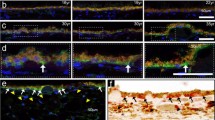Abstract
Background
The aim of this work was to investigate the choroidal morphologic changes of Vogt–Koyanagi–Harada (VKH) disease in vivo using high-penetration optical coherence tomography (HP-OCT) with a long-wavelength light source (1,060 nm).
Methods
Fourteen patients with VKH disease were included in this study: 12 eyes of six patients with treatment-naive acute VKH in the first 6–12 months after diagnosis and 16 eyes of eight patients in the convalescent phase with a sunset glow fundus appearance. A prototype HP-OCT instrument was used to observe the deep choroid and sclera. The choroidal thickness was measured for more than 6 months in eyes with acute disease. The choroidal thickness in patients with a sunset glow fundus appearance for 2–9 years after the onset was also examined.
Results
In 12 eyes with acute VKH disease, the baseline choroidal thickness was significantly (p < 0.0001) greater than in controls. After treatment, the choroidal thickness decreased over time. However, the choroidal thickness increased markedly again in four eyes with recurrent disease. The mean thickness at 12 months was significantly less than the normal value (p < 0.0001). In 16 eyes with a sunset glow fundus appearance, the choroidal thickness was significantly (p < 0.0001) thinner compared to the controls.
Conclusions
Significant choroidal thickness changes underlie VKH disease, which progress over time. Objective measurement of the choroidal thickness using HP-OCT may be useful for longitudinal evaluation of VKH activity.





Similar content being viewed by others
References
Moorthy RS, Inomata H, Rao NA (1995) Vogt–Koyanagi–Harada syndrome. Surv Ophthalmol 39:265–292
Inomata H, Rao NA (2001) Depigmented atrophic lesions in sunset glow fundi of Vogt–Koyanagi–Harada disease. Am J Ophthalmol 131:607–614
Inomata H, Sakamoto T (1990) Immunohistochemical studies of Vogt–Koyanagi–Harada disease with sunset sky fundus. Curr Eye Res 9(Suppl):35–40
Perry HD, Font RL (1977) Clinical and histopathologic observations in severe Vogt–Koyanagi–Harada syndrome. Am J Ophthalmol 83:242–254
Inomata H, Minei M, Taniguchi Y, Nishimura F (1983) Choroidal neovascularization in long-standing case of Vogt–Koyanagi–Harada disease. Jpn J Ophthalmol 27:9–26
Rao NA (2007) Pathology of Vogt–Koyanagi–Harada disease. Int Ophthalmol 27:81–85
Ikuno Y, Tano Y (2009) Retinal and choroidal biometry in highly myopic eyes with spectral-domain optical coherence tomography. Invest Ophthalmol Vis Sci 50:3876–3880
Unterhuber A, Povazay B, Hermann B, Sattmann H, Chavez-Pirson A, Drexler W (2005) In vivo retinal optical coherence tomography at 1040 nm - enhanced penetration into the choroid. Opt Express 13:3252–3258
Lee EC, de Boer JF, Mujat M, Lim H, Yun SH (2006) In vivo optical frequency domain imaging of human retina and choroid. Opt Express 14:4403–4411
Yasuno Y, Hong Y, Makita S, Yamanari M, Akiba M, Miura M, Yatagai T (2007) In vivo high-contrast imaging of deep posterior eye by 1-mm swept source optical coherence tomography and scattering optical coherence angiography. Opt Express 15:6121–6139
Huber R, Adler DC, Srinivasan VJ, Fujimoto JG (2007) Fourier domain mode locking at 1050 nm for ultra-high-speed optical coherence tomography of the human retina at 236,000 axial scans per second. Opt Lett 32:2049–2051
Srinivasan VJ, Adler DC, Chen Y, Gorczynska I, Huber R, Duker JS, Schuman JS, Fujimoto JG (2008) Ultrahigh-speed optical coherence tomography for three-dimensional and en face imaging of the retina and optic nerve head. Invest Ophthalmol Vis Sci 49:5103–5110
Maruko I, Iida T, Sugano Y, Ojima A, Ogasawara M, Spaide RF (2010) Subfoveal choroidal thickness after treatment of central serous chorioretinopathy. Ophthalmology 117:1792–1799
Spaide RF, Koizumi H, Pozonni MC (2008) Enhanced depth imaging spectral-domain optical coherence tomography. Am J Ophthalmol 146:496–500
Maruko I, Iida T, Sugano Y, Oyamada H, Sekiryu T, Fujiwara T, Spaide RF (2011) Subfoveal choroidal thickness after treatment of Vogt–Koyanagi–Harada disease. Retina 31:510–517
Ikuno Y, Kawaguchi K, Yasuno Y, Nouchi T (2010) Choroidal thickness in healthy Japanese subjects. Invest Ophthalmol Vis Sci 51:2173–2176
Fong AH, Li KK, Wong D (2011) Choroidal evaluation using enhanced depth imaging spectral-domain optical coherence tomography in Vogt–Koyanagi–Harada disease. Retina 31:502–509
Suzuki S (1999) Quantitative evaluation of "sunset glow" fundus in Vogt–Koyanagi–Harada disease. Jpn J Ophthalmol 43:327–333
Kawaguchi T, Horie S, Bouchenaki N, Ohno-Matsui K, Mochizuki M, Herbort CP (2010) Suboptimal therapy controls clinically apparent disease but not subclinical progression of Vogt–Koyanagi–Harada disease. Int Ophthalmol 30:41–50
Keino H, Goto H, Usui M (2002) Sunset glow fundus in Vogt–Koyanagi–Harada disease with or without chronic ocular inflammation. Graefes Arch Clin Exp Ophthalmol 240:878–882
Herbort CP, Mantovani A, Bouchenaki N (2007) Indocyanine green angiography in Vogt–Koyanagi–Harada disease: angiographic signs and utility in patient follow-up. Int Ophthalmol 27:173–182
Author information
Authors and Affiliations
Corresponding author
Additional information
The authors have no proprietary interests in any aspect of this report.
Rights and permissions
About this article
Cite this article
Nakai, K., Gomi, F., Ikuno, Y. et al. Choroidal observations in Vogt–Koyanagi–Harada disease using high-penetration optical coherence tomography. Graefes Arch Clin Exp Ophthalmol 250, 1089–1095 (2012). https://doi.org/10.1007/s00417-011-1910-7
Received:
Revised:
Accepted:
Published:
Issue Date:
DOI: https://doi.org/10.1007/s00417-011-1910-7




